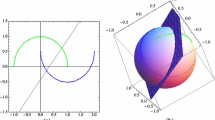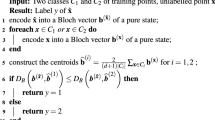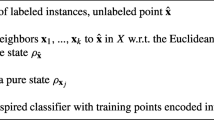Abstract
We address the problem of binary classification by using a quantum version of the Nearest Mean Classifier (NMC). Our proposal is indeed an advanced version of previous one (see Sergioli et al. 2017 that i) is able to be naturally generalized to arbitrary number of features and ii) exhibits better performances with respect to the classical NMC for several datasets. Further, we show that the quantum version of NMC is not invariant under rescaling. This allows us to introduce a free parameter, i.e. the rescaling factor, that could be useful to get a further improvement of the classification performance.

Similar content being viewed by others
Notes
For the sake of the clarity regarding the indexes, we accord to use superscript index to indicate the different components of the vector and subscript to indicate different vectors.
References
Aerts, D., Sozzo, S.: Quantum structure in cognition: Why and how concepts are entangled. Lect. Notes Comput. Sci 7052, 116–127 (2011)
Aerts, D., Sozzo, S., Gabora, L., Veloz, T.: Quantum Structure in Cognition: Fundamentals and Applications. In: Privman, V., Ovchinnikov, V. (eds.) ICQNM 2011: The Fifth International Conference on Quantum, Nano and Micro Technologies (2011)
Aïmeur, E., Brassard, G., Gambs, S.: Machine learning in a quantum world Conference of the Canadian Society for Computational Studies of Intelligence Springer Berlin Heidelberg (2006)
Dalla Chiara, M.L., Giuntini, R., Leporini, R., Sergioli, G.: Holistic logical arguments in quantum computation. Mathematica Slovaca 2, 66 (2016)
Dalla Chiara, M.L., Giuntini, R., Leporini, R., Negri, E., Sergioli, G.: Quantum information, cognition and music. Front. Psychol., 6–1583 (2015)
Duda, R.O., Hart, P.E., Stork, D.G.: Pattern Classification. Wiley Interscience, 2nd edition (2000)
Eisert, J., Wilkens, M., Lewenstein, M.: Quantum games and quantum strategies. Phys. Rev. Lett. 83(15), 3077 (1999)
Eldar, Y.C., Oppenheim, A.V.: Quantum signal processing. IEEE Signal Process. Mag. 19(6), 12–32 (2002)
Gambs, S.: Quantum classification, arXiv:0809.0444v2 [quant-ph] (2008)
Helstrom, C.W.: Quantum Detection and Estimation Theory, Academic Press (1976)
Holik, F., Sergioli, G., Freytes, H., Plastino, A.: Pattern Recognition in non-Kolmogorovian Structures Foundations of Science (2017)
Lloyd, S., Mohseni, M., Rebentrost, P.: Quantum algorithms for supervised and unsupervised machine learning. arXiv:1307.0411 [quant-ph] (2013)
Lloyd, S., Mohseni, M., Rebentrost, P.: Quantum principal component analysis. Nat. Phys. 10(9), 631–633 (2014)
Manju, A., Nigam, M.J.: Applications of quantum inspired computational intelligence: a survey. Artif. Intell. Rev. 42(1), 79–156 (2014)
Nielsen, M.A., Chuang, I.L.: Quantum Computation and Quantum Information - 10th Anniversary Edition. Cambridge university press, Cambridge (2010)
Piotrowski, E.W., Sladkowski, J.: An invitation to quantum game theory. Int. J. Theor. Phys. 42(5), 1089–1099 (2003)
QP-PQ: Quantum Probability and White Noise Analysis: Volume 21. Quantum Bio-Informatics II, From Quantum Information to Bio-Informatics, World Scientific (2008)
Schuld, M., Sinayskiy, I., Petruccione, F.: An introduction to quantum machine learning. Contemp. Phys. 56(2), 172–185 (2014)
Schuld, M., Sinayskiy, I., Petruccione, F.: The quest for a Quantum Neural Network. Quantum Inf. Process 13(11), 2567–2586 (2014)
Sergioli, G., Santucci, E., Didaci, L., Miszczak, J.A., Giuntini, R.: A quantum inspired version of the NMC classifier. Soft Computing (forthcoming) (2017)
Schuld, M., Sinayskiy, I., Petruccione, F.: An introduction to quantum machine learning. Contemp. Phys. 56(2) (2014). arXiv:1409.3097
Wittek, P.: Quantum machine learning: What quantum computing means to data mining academic press (2014)
Acknowledgements
This work is supported by the Sardinia Region Project ”Modeling the uncertainty: quantum theory and imaging processing”, LR 7/8/2007. RAS CRP-59872 and by the Firb Project ”Structures and Dynamics of Knowledge and Cognition” [F21J12000140001]. GMB acknowledges support from CONICET and UNLP (Argentina).
Author information
Authors and Affiliations
Corresponding author
Rights and permissions
About this article
Cite this article
Sergioli, G., Bosyk, G.M., Santucci, E. et al. A Quantum-inspired Version of the Classification Problem. Int J Theor Phys 56, 3880–3888 (2017). https://doi.org/10.1007/s10773-017-3371-1
Received:
Accepted:
Published:
Issue Date:
DOI: https://doi.org/10.1007/s10773-017-3371-1




